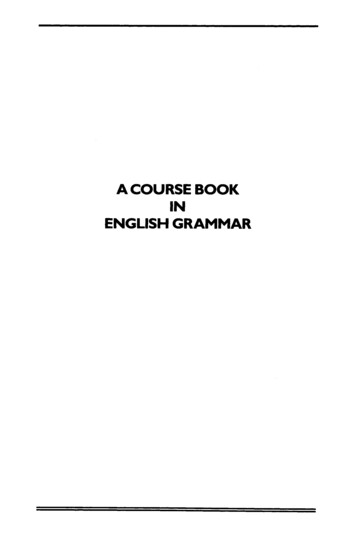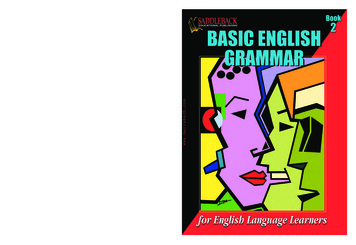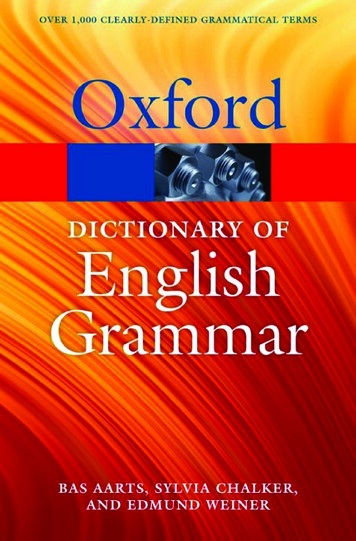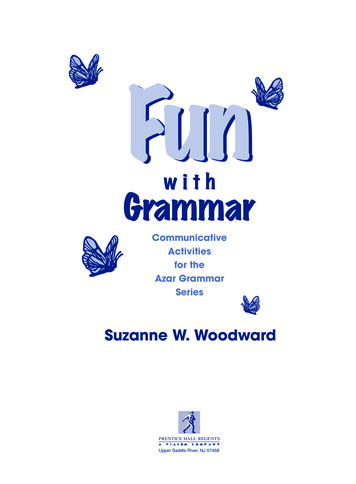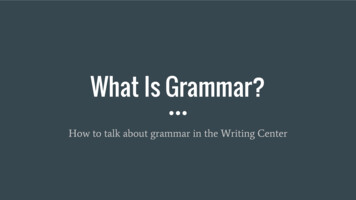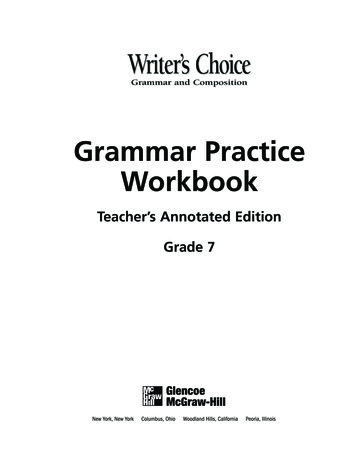
Transcription
Grammar and CompositionGrammar PracticeWorkbookTeacher’s Annotated EditionGrade 7
Glencoe/McGraw-HillCopyright The McGraw-Hill Companies, Inc. All rights reserved. Permission isgranted to reproduce material contained herein on the condition that such materials bereproduced only for classroom use; and be provided to students, teachers, and familieswithout charge; and be used solely in conjunction with Writer’s Choice. Any otherreproduction, for use or sale, is prohibited without written permission of the publisher.Printed in the United States of America.Send all inquiries to:Glencoe/McGraw-Hill8787 Orion PlaceColumbus, Ohio 43240ISBN 0-07-823360-71 2 3 4 5 6 7 8 9 024 04 03 02 01 00ii
ContentsUnit 8Subjects, Predicates, and Sentences8.1–28.3, 58.48.6Unit 9Sentences and Sentence Fragments. . . . . . . . . . . . . . . . . . . . . . . . . . . . . . . . . 1Subjects and Predicates . . . . . . . . . . . . . . . . . . . . . . . . . . . . . . . . . . . . . . . . . . 2Identifying the Subject . . . . . . . . . . . . . . . . . . . . . . . . . . . . . . . . . . . . . . . . . . 3Simple and Compound Sentences . . . . . . . . . . . . . . . . . . . . . . . . . . . . . . . . . 4Nouns9.1–2, 5 Proper, Compound and Collective Nouns . . . . . . . . . . . . . . . . . . . . . . . . . . . 59.3–4Distinguishing Plurals, Possessives, and Contractions . . . . . . . . . . . . . . . . . . 69.6Appositives. . . . . . . . . . . . . . . . . . . . . . . . . . . . . . . . . . . . . . . . . . . . . . . . . . . . 7Unit 10Verbs10.210.310.410.510.610.7–810.9–10Unit 11Pronouns11.111.211.411.511.6–7Unit 12Personal Pronouns . . . . . . . . . . . . . . . . . . . . . . . . . . . . . . . . . . . . . . . . . . . . 15Pronouns and Antecedents . . . . . . . . . . . . . . . . . . . . . . . . . . . . . . . . . . . . . . 16Possessive Pronouns . . . . . . . . . . . . . . . . . . . . . . . . . . . . . . . . . . . . . . . . . . . 17Indefinite Pronouns . . . . . . . . . . . . . . . . . . . . . . . . . . . . . . . . . . . . . . . . . . . 18Reflexive, Intensive, and Interrogative Pronouns . . . . . . . . . . . . . . . . . . . . . 19Adjectives and it 13Transitive and Intransitive Verbs. . . . . . . . . . . . . . . . . . . . . . . . . . . . . . . . . . . 8Verbs with Indirect Objects. . . . . . . . . . . . . . . . . . . . . . . . . . . . . . . . . . . . . . . 9Linking Verbs and Predicate Words . . . . . . . . . . . . . . . . . . . . . . . . . . . . . . . 10Present, Past, and Future Tenses . . . . . . . . . . . . . . . . . . . . . . . . . . . . . . . . . . 11Main Verbs and Helping Verbs . . . . . . . . . . . . . . . . . . . . . . . . . . . . . . . . . . . 12Progressive Forms and Perfect Tenses. . . . . . . . . . . . . . . . . . . . . . . . . . . . . . 13Irregular Verbs. . . . . . . . . . . . . . . . . . . . . . . . . . . . . . . . . . . . . . . . . . . . . . . . 14Adjectives, Articles, and Proper Adjectives . . . . . . . . . . . . . . . . . . . . . . . . . . 20Comparative and Superlative Adjectives . . . . . . . . . . . . . . . . . . . . . . . . . . . 21Demonstratives . . . . . . . . . . . . . . . . . . . . . . . . . . . . . . . . . . . . . . . . . . . . . . . 22Adverbs and Intensifiers . . . . . . . . . . . . . . . . . . . . . . . . . . . . . . . . . . . . . . . . 23Comparative and Superlative Adverbs . . . . . . . . . . . . . . . . . . . . . . . . . . . . . 24Using Adverbs and Adjectives . . . . . . . . . . . . . . . . . . . . . . . . . . . . . . . . . . . . 25Avoiding Double Negatives. . . . . . . . . . . . . . . . . . . . . . . . . . . . . . . . . . . . . . 26Prepositions, Conjunctions, and Interjections13.113.213.313.4–5Prepositions and Prepositional Phrases . . . . . . . . . . . . . . . . . . . . . . . . . . . . 27Pronouns as Objects of Prepositions . . . . . . . . . . . . . . . . . . . . . . . . . . . . . . 28Prepositional Phrases as Adjectives and Adverbs . . . . . . . . . . . . . . . . . . . . . 29Conjunctions and Interjections . . . . . . . . . . . . . . . . . . . . . . . . . . . . . . . . . . 30iii
ContentsUnit 14Clauses and Complex Sentences14.114.214.314.414.5Unit 15Verbals15.115.215.3Unit 16Capitalization I . . . . . . . . . . . . . . . . . . . . . . . . . . . . . . . . . . . . . . . . . . . . . . . 43Capitalization II . . . . . . . . . . . . . . . . . . . . . . . . . . . . . . . . . . . . . . . . . . . . . . ��10ivUsing Troublesome Words . . . . . . . . . . . . . . . . . . . . . . . . . . . . . . . . . . . . . . 42Capitalization19.1–219.3–4Unit 20Making Subjects and Verbs Agree . . . . . . . . . . . . . . . . . . . . . . . . . . . . . . . . . 39Problems with Locating the Subject . . . . . . . . . . . . . . . . . . . . . . . . . . . . . . . 40Special Subjects . . . . . . . . . . . . . . . . . . . . . . . . . . . . . . . . . . . . . . . . . . . . . . . 41Glossary of Special Usage Problems17.1–2Unit 19Participles and Participial Phrases . . . . . . . . . . . . . . . . . . . . . . . . . . . . . . . . 36Gerunds and Gerund Phrases. . . . . . . . . . . . . . . . . . . . . . . . . . . . . . . . . . . . 37Infinitives and Infinitive Phrases . . . . . . . . . . . . . . . . . . . . . . . . . . . . . . . . . 38Subject-Verb Agreement16.1, 516.216.3–4Unit 17Sentences and Clauses. . . . . . . . . . . . . . . . . . . . . . . . . . . . . . . . . . . . . . . . . . 31Complex Sentences . . . . . . . . . . . . . . . . . . . . . . . . . . . . . . . . . . . . . . . . . . . . 32Adjective Clauses. . . . . . . . . . . . . . . . . . . . . . . . . . . . . . . . . . . . . . . . . . . . . . 33Adverb Clauses . . . . . . . . . . . . . . . . . . . . . . . . . . . . . . . . . . . . . . . . . . . . . . . 34Noun Clauses . . . . . . . . . . . . . . . . . . . . . . . . . . . . . . . . . . . . . . . . . . . . . . . . 35Using the Period and Other End Marks . . . . . . . . . . . . . . . . . . . . . . . . . . . . 45Using Commas I . . . . . . . . . . . . . . . . . . . . . . . . . . . . . . . . . . . . . . . . . . . . . . 46Using Commas II . . . . . . . . . . . . . . . . . . . . . . . . . . . . . . . . . . . . . . . . . . . . . 47Using Commas III. . . . . . . . . . . . . . . . . . . . . . . . . . . . . . . . . . . . . . . . . . . . . 48Using Semicolons and Colons . . . . . . . . . . . . . . . . . . . . . . . . . . . . . . . . . . . 49Using Quotation Marks and Italics. . . . . . . . . . . . . . . . . . . . . . . . . . . . . . . . 50Using Apostrophes, Hyphens, Dashes, and Parentheses. . . . . . . . . . . . . . . . 51Using Abbreviations and Writing Numbers . . . . . . . . . . . . . . . . . . . . . . . . . 52
Grammar PracticeName . Class . Date .8.1–2Sentences and Sentence FragmentsKey InformationA sentence is a group of words thatexpresses a complete thought. A sentenceconsists of a subject and a predicate. Agroup of words that does not have bothparts does not express a complete thoughtand is called a sentence fragment.Every sentence begins with a capital letterand ends with a period, question mark, orexclamation point.A declarative sentence makes a statement.An interrogative sentence asks aquestion.How old is this pyramid?An exclamatory sentence expressesstrong feeling.How steep the sides are!An imperative sentence gives a commandor makes a request.Take a photo of this scene.Mexico has many pyramids. A. Recognizing Sentences and Kinds of SentencesDecide whether each of these groups of words is a sentence or a sentence fragment. Ifit is a sentence, write whether it is declarative, interrogative, exclamatory, or imperative.If it is not a complete sentence, write fragment.exclamatory1. What a long day I had!fragment2. Juyong, too.declarative3. The full moon is shining between the clouds tonight.Copyright The McGraw-Hill Companies, Inc.interrogative4. Did you turn off the lights?imperative5. Remember to bring an umbrella.fragment6. On the third shelf. B. Correcting Sentence FragmentsAdd words to each sentence fragment to form the kind of sentence indicated inparentheses. Add the correct end punctuation. Sentences will vary.1. the natives of North America (declarative)2. after school today (imperative)3. finished your homework (interrogative)4. great concert (exclamatory)Writer’s Choice: Grammar Practice Workbook, Grade 7, Unit 81
Grammar PracticeName . Class . Date .8.3, 5Subjects and PredicatesKey InformationAll of the words in the subject make up thecomplete subject. The main word or groupof words in the subject is called the simplesubject. All of the words in the predicatemake up the complete predicate. Themain word or group of words in the predicate is called the simple predicate.The simple subject is usually a noun or apronoun; the simple predicate is alwaysa verb.The red car is in the lead.A compound subject has two or moresimple subjects joined by and, or, or nor.The red car and its driver are in the lead.When the simple subjects are joined byand, the compound subject is plural andtakes the plural form of the verb. When thesimple subjects are joined by or or nor, theverb agrees with the nearer subject.Either the red car or the two blue onesuse gasohol.A compound predicate has two or moreverbs with the same subject.He skids but stays ahead.The verbs are joined by and, or, nor, but,or yet. A. Recognizing Sentence PartsUnderline each complete subject once and each complete predicate twice. Write eachsimple subject and simple predicate, or verb.Shama; exercises1. Shama exercises every day.Children; scrambled2. Children at the party scrambled for the balloons.cactus, century plant,4. The cactus, the century plant, and sagebrush grow in the desert.sagebrush; grow B. Combining Sentence PartsCombine each pair of sentences by forming a compound subject or compoundpredicate. Remember to use the correct form of each verb.1. Usually, on a picnic, ants sting me. Or a bee stings me.Usually, on a picnic, ants or a bee stings me.2. The cloth has a high price. But the cloth is just right for your costume.The cloth has a high price but is just right for your costume.2Writer’s Choice: Grammar Practice Workbook, Grade 7, Unit 8Copyright The McGraw-Hill Companies, Inc.brother; met, went3. My brother met his best friend and went to the movie.
Grammar PracticeName . Class . Date .8.4Identifying the SubjectKey InformationMost sentences begin with the subject.Temperatures fall at night.Many questions begin with a word that ispart of the predicate.In sentences beginning with Here is, Hereare, There is, or There are, the predicateprecedes the subject.Here are today’s statistics.In commands, the word you is the understood subject.Do clouds affect temperature?Rearranging the words to form a statementhelps to locate the subject.(You) Keep a daily record.Clouds do affect temperature. A. Locating the SubjectUnderline the complete subject in each of these sentences. If the sentence is acommand, write (You) on the line before the sentence.1. Do spiders have six legs or eight legs?You2. Listen to the directions.3. The man in the tall hat is a magician.4. Is this apple a Red Delicious?5. In the museum there were many Roman statues.Copyright The McGraw-Hill Companies, Inc. B. Rewriting Sentences for VarietyRearrange the words of each of the following sentences as indicated. Write your revisedsentence in the space provided. Write a sentence of your own at the end.1. You should imagine my delight at holding a koala. (Use the understood You.)Imagine my delight at holding a koala.2. Your shoes are here under the chair (Begin with Here are.)Here are your shoes under the chair.3. You have drawn with charcoal. (Use a question.)Have you drawn with charcoal?4. (Write an exclamatory sentence.)Sentences will vary.Writer’s Choice: Grammar Practice Workbook, Grade 7, Unit 83
Grammar PracticeName . Class . Date .8.6Simple and Compound SentencesKey InformationA simple sentence has one complete subject and one complete predicate.Either the dog or the baby bumped the lamp and broke it.A compound sentence contains two or more simple sentences joined by either a commaand a coordinating conjunction or by a semicolon.I took the lamp in for repair, but the job cost too much.A run-on sentence consists of two or more sentences incorrectly joined.INCORRECT:A new lamp will be cheaper, I’ll buy a strong one.To correct a run-on, write separate sentences, or if the sentences are closely related, jointhem using a semicolon or a comma and a conjunction.CORRECT:A new lamp will be cheaper. I’ll buy a strong one. A. Recognizing Subjects and Predicates in Compound SentencesUnderline each complete subject once and each complete predicate twice. Circlethe coordinating conjunctions and, but, or or when they are used to connect twosimple sentences.1. My cousin moved to Mexico City, and I may visit her soon.2. We saw the Pyramid of the Sun on the last trip, but my eldest brother missed thetour of the Palace.instead.4. Jamil shoots baskets and tosses rings in the fairway, but Kendra enjoys the exhibits. B. Identifying Simple Sentences, Compound Sentences, and Run-onsWrite whether each sentence is simple, compound, or run-on. If the sentence is a runon, rewrite it correctly.simple1. Milk, broccoli, and kale are good sources of calcium.run-on2. This song is by Carly Simon I like it.This song is by Carly Simon; I like it.run-on3. Ted bakes cookies, chocolate chip cookies are his favorites.Ted bakes cookies. Chocolate chip cookies are his favorites.compound4. Raoul is interested in astronomy, and he owns a telescope.4Writer’s Choice: Grammar Practice Workbook, Grade 7, Unit 8Copyright The McGraw-Hill Companies, Inc.3. Jamil and Kendra sometimes ride the ferris wheel, or they choose the scrambler
Grammar PracticeName . Class . Date .9.1–2, 5Proper, Compound, and Collective NounsKey InformationCommon nouns name any person, place, thing, or idea. Common nouns can be eitherconcrete or abstract. Concrete nouns name things you can see or touch.Abstract nouns name ideas or feelings.Proper nouns name a specific person, place, thing, or idea. They begin with a capital letter.Compound nouns are made up of two or more words. They can be written as one word, astwo or more separate words, or as two or more words joined by hyphens. To write the pluralform of compound nouns of two or more words, make the most important word plural.Collective nouns name a group of individuals. When the collective noun refers to the groupas a unit, use a singular verb. When the collective noun refers to the individual members ofthe group, use a plural verb. A. Identifying NounsUnderline the nouns in the following sentences. Circle letters that should becapitalized.1. The garden is filled with tulips and daffodils.2. These roses were developed in richmond, virginia.3. The newspaper published an article about our club at superior middle school.4. On monday, january 6, rene returns from vacation.Copyright The McGraw-Hill Companies, Inc. B. Forming PluralsWrite the plural form of each compound noun.sidewalks1. sidewalkconcert halls3. concert hallattorneys-at-law2. attorney-at-lawseaports4. seaport C. Using Collective NounsUnderline the correct verb form in parentheses.1. The herd (graze, grazes) in this field every afternoon.2. The herd (lift, lifts) their heads at the sound of the gunshot.3. The jury (deliberates, deliberate) in a secluded room.4. The jury (disagree, disagrees) about the verdict.Writer’s Choice: Grammar Practice Workbook, Grade 7, Unit 95
Grammar PracticeName . Class . Date .9.3–4Distinguishing Plurals, Possessives, and ContractionsKey InformationPossessive nouns name who or whatowns or has something. They can besingular or plural.The dogs’ names are Trooper and Sam.Traci’s dog can do tricks.To form the possessive of all singular nounsand plural nouns not ending in s, add anapostrophe and s.sunmenbossTo form the possessive of plural nounsalready ending in s, add only an apostrophe.girlsgirls’An apostrophe is also used to indicatewhere letters have been left out in a contraction. A contraction is a word made bycombining two words into one by leavingout one or more letters.sun’smen’sboss’sBrad’s the fastest runner in the school.(Brad is) A. Forming Possessives and ContractionsAdd apostrophes where needed and indicate whether the word with the apostropheis a singular possessive noun, a plural possessive noun, or a contraction by writingS, P, or C in the space next to the word.flashlight’s, S1. The new flashlights beam is powerful.Babbage’s, S2. Charles Babbages invention led to the modern computer.trees’, P3. These trees bark must be stripped before their wood can be made into paper.song’s, S5. This songs words are difficult to understand.girls’, P6. The girls uniforms were attractive and practical. B. Using Possessives and ContractionsUnderline the word in parentheses that correctly completes the sentence.1. This (cartoons, cartoon’s) characters are realistic.2. Our (newspapers’, newspaper’s) late this morning.3. Tighten these (guitars’, guitar’s) strings.4. (Joans, Joan’s) Siamese cat won a prize at the pet show.6Writer’s Choice: Grammar Practice Workbook, Grade 7, Unit 9Copyright The McGraw-Hill Companies, Inc.Deanne’s, S; family’s, C4. Deannes familys moving to Tennessee.
Grammar PracticeName . Class . Date .9.6AppositivesKey InformationAn appositive is a noun placed next to another noun to identify it or add informationabout it.Mrs. Campbell, the principal, read today’s announcements.An appositive phrase is a group of words that includes an appositive and other words thatdescribe the appositive.Pontiac, the great chief of the Ottawa nation, died in 1769.An appositive is set off by commas if it is not absolutely necessary to the meaning ofthe sentence.A respected architect, I. M. Pei has designed many buildings.I. M. Pei, a respected architect, designed the building. A. Identifying AppositivesUnderline the appositive phrases in the following sentences. Add commaswhere necessary. Carets indicate missing punctuation.Copyright The McGraw-Hill Companies, Inc.1. The title of the play comes from a work by Langston Hughes, an African American poet.2. An ardent fan of the Bulls, Jason rejoiced at their victory. 3. We celebrated at Paul’s, the finest French restaurant in town. 4. Our teacher asked Kristin ,the foreign exchange student from Germany, to tell us a little about her homeland.5. The fair will be held on Hester Court ,a street with many small shops. B. Using AppositivesWrite four sentences about yourself or the members of your family. Use an appositivein each. Sentences will vary.1.2.3.4.Writer’s Choice: Grammar Practice Workbook, Grade 7, Unit 97
Grammar PracticeName . Class . Date .10.2Transitive and Intransitive VerbsKey InformationA direct object receives the action of a verb. It answers the question whom? or what? afteran action verb.Garrett Morgan invented the traffic signal.An action verb may have one, more than one, or no direct object. An action verb that hasa direct object is a transitive verb. An action verb that does not have a direct object is anintransitive verb. A. Identifying Transitive and Intransitive VerbsUnderline each action verb in the following sentences. Indicate whether the verbis transitive or intransitive by writing T or I in the space above the word. In thosesentences with a transitive verb, circle the direct object. B. Changing Intransitive Verbs to Transitive VerbsRewrite each sentence, adding at least one direct object.Example: Lamar wove on the antique loom.Lamar wove cloth on the antique loom.Possible answers are given.The school choir sang three songs.1. The school choir sang.After the rain, the gardener planted lettuce and radishes.2. After the rain, the gardener planted.Emily studied history in the library.3. Emily studied in the library.8Writer’s Choice: Grammar Practice Workbook, Grade 7, Unit 10Copyright The McGraw-Hill Companies, Inc.T1. The astronauts collected rocks on the moon.T2. Joan Benoit won the first Olympic women’s marathon.I3. Gracefully, the swimmer dived under the water.T4. The musician plucked the strings of the guitar.I5. Heavy rain fell in Florida.T6. The police officer directed traffic through the intersection.T7. Erin hummed the tune happily.T8. President Franklin Roosevelt collected stamps.
Grammar PracticeName . Class . Date .10.3Verbs with Indirect ObjectsKey InformationSome sentences have both a direct object and an indirect object. An indirect object tellsto whom or for whom an action is done.The girl gave the cat a toy.The indirect object always comes before the direct object. You can check that an indirectobject is indeed the indirect object by silently adding to or for before the indirect objectand changing its position in the sentence. The sentence should still make sense.The girl gave a toy (to the cat). A. Identifying Direct and Indirect ObjectsCopyright The McGraw-Hill Companies, Inc.Each of these sentences has a direct object. Some of them have indirect objects.Fill in the answer columns with the direct and indirect objects you find.Direct ObjectIndirect Object1. The store manager promised me a refund.refundme2. Will you lend me your book?bookme3. Ask the teacher your question.questionteacher4. The bear caught a large salmon.salmon5. Pick the ripe tomatoes from the garden.tomatoes6. The principal awarded Rachel first prize.prizeRachel7. Lydia threw her teammate the ball.ballteammate8. Who left me this note?noteme B. Working with ObjectsWrite whether the underlined word in each of the following sentences is a direct objector an indirect object. Then rewrite each sentence, replacing the underlined object witha new object.direct object1. Mr. Chavez drew her a map.Mr. Chavez drew her a picture.indirect object2. Paul showed Scotty his pet turtle.Paul showed me his pet turtle.direct object3. The mail carrier gave my neighbor the package.The mail carrier gave my neighbor the letter.indirect object4. I sent my mother flowers for her birthday.I sent my sister flowers for her birthday.Writer’s Choice: Grammar Practice Workbook, Grade 7, Unit 109
Grammar PracticeName . Class . Date .10.4Linking Verbs and Predicate WordsKey InformationA linking verb connects the subject of a sentence with a noun or an adjective in thepredicate.Good actors become their characters.Common linking verbs are be, become, seem, look, smell, turn, sound, grow, remain, andfeel. Some linking verbs may also be used as action verbs.A predicate noun is a noun that follows a linking verb and tells what the subject is.My best friend is the star of her class play.A predicate adjective is an adjective that follows a linking verb and describes the subject.Cast members feel nervous. A. Recognizing Sentence PatternsCopy the verb of each sentence. Write whether it is an action verb or a linkingverb. If it is a linking verb, write whether it is followed by a predicate noun ora predicate adjective.linking; predicate adjective1. After the long hike, the Scouts were hungry and tired.linking; predicate noun2. George Bush was our forty-first president.linking; predicate adjective3. The pink sky at sunset looked beautiful.linking; predicate adjective5. The fresh-baked cookies smelled delicious.linking; predicate adjective6. After the rain the river turned muddy.linking; predicate noun7. The prairie wildflowers were daisies.linking; predicate adjective8. Rafael looked happy about his test score. B. Revising SentencesUnderline the predicate noun or predicate adjective in each sentence. Then rewriteeach sentence, replacing the predicate noun or predicate adjective with another wordthat makes sense in that position. Possible replacements.believable1. His excuse sounded silly to me.governor2. The candidate became our new mayor.anxious3. The large audience grew restless.pen pals4. Carol and Diane remained friends.10Writer’s Choice: Grammar Practice Workbook, Grade 7, Unit 10Copyright The McGraw-Hill Companies, Inc.action4. Laura studied architecture.
Grammar PracticeName . Class . Date .10.5Present, Past, and Future TensesKey InformationA verb changes form to show tense and toagree with its subject. The tense of a verbtells when the action takes place.The present tense names an action thathappens regularly. It is also used to expressgeneral truths. In the present tense the baseform of the verb is used, except when thesubject is a singular noun or the pronounshe, she, or it. With those subjects, you add-s or -es to the base form of the verb.That rooster crows more loudly.The past tense names an action that hasalready happened. Many verbs in the pasttense end in -d or -ed.Matt refilled the feeder.The future tense names an action yet tohappen. The word will is used with the verbto express future tense.Next year, Kay will raise hens.Your roosters crow loudly. A. Identifying the Tense of a VerbUnderline the verb in each sentence. In the space provided, write whether the tenseof the verb is present, past, or future.future 1. As usual, Carl will guess the ending of the mystery.present2. Karen exercises every day.past 3. Mary Ann Mantell found one of the first dinosaur bones.present4. I am the winner!Copyright The McGraw-Hill Companies, Inc.future 5. The concert will begin soon.past 6. Nancy Kerrigan skated at the Winter Olympics in 1992. B. Making a Present-Tense Verb Agree with Its SubjectRewrite each sentence, changing the verb from past tense to present tense. Make surethe verb agrees with the subject.1. Taryn walked the dog every day.Taryn walks the dog every day.2. Both of Dan’s cats liked ice cream.Both of Dan’s cats like ice cream.3. Your clock ticked so loudly!Your clock ticks so loudly!4. Laquetis practiced the trumpet every day after school.Laquetis practices the trumpet every day after school.Writer’s Choice: Grammar Practice Workbook, Grade 7, Unit 1011
Grammar PracticeName . Class . Date .10.6Main Verbs and Helping VerbsKey InformationVerbs have four principal parts: base form(look), present participle (looking), pastform (looked), and past participle(looked).Any of the principal parts of a verb exceptthe past form may be combined with ahelping verb such as be, have, or do.When one or more helping verbs are usedwith a main verb, a verb phrase is formed.Forms of be—am, is, and are in the presentand was and were in the past—combinewith the present participle of the verb.We are walking now.We were jogging before.Forms of have—have and has in the presentand had in the past—combine with thepast participle of the verb.You have walked faster often. A. Analyzing Verb PhrasesUnderline each verb or verb phrase. If the verb phrase includes a participle, write theparticiple on the line provided, and indicate whether it is a present or past participle.predicted; past1. Scientists have predicted an end to the world’s rain forests.changing; present2. The leaves are changing very slowly this year.3. That city was the birthplace of the sundae.frightened; past4. Leslie’s monster costume had frightened some of the little children.5. Some time before her solo flight, Earhart had traveled across the Atlantic on anotherbringing; present6. Who is bringing the paper plates?danced; past7. Camille has danced to classical, jazz, and folk music.using; present8. We are using percussion instruments in our presentation.9. Tree frogs cling to the bark of trees.walking; present10. Are you walking home after school today? B. Using Helping VerbsUnderline the correct form of the helping verb in parentheses.1. For the last four years, Jeff (has, is) played in a softball league.2. Hundreds of bats (have, are) living in this cave.3. Juan and Terry (had, were) helping at the shelter.4. Before the storm, Nancy (had, was) created a sidewalk chalk painting.5. At the moment, I (have, am) searching for my glasses.12Writer’s Choice: Grammar Practice Workbook, Grade 7, Unit 10Copyright The McGraw-Hill Companies, Inc.traveled; pastrecord-setting journey.
Grammar PracticeName .
4 Writer ’s Choice: Grammar Practice Workbook,Grade 7, Unit 8 A. Recognizing Subjects and Predicates in Compound Sentences Underline each complete subject once and each complete predicate twice. Circle the coordinating conjunctions and, but, or or when they are used to connect two simple sentences. 1.File Size: 754KBPage Count: 56


